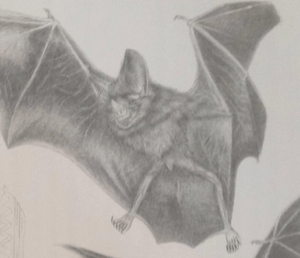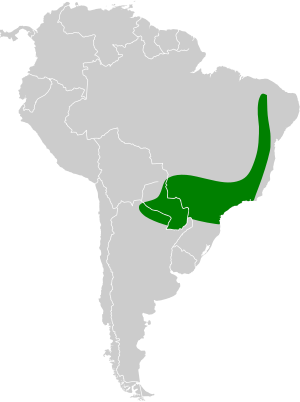Greater round-eared bat facts for kids
Quick facts for kids Greater round-eared bat |
|
|---|---|
 |
|
| Conservation status | |
| Scientific classification | |
| Genus: |
Tonatia
|
| Species: |
bidens
|
 |
|
The greater round-eared bat (Tonatia bidens) is a fascinating bat species. It lives in parts of South America, including northeastern and southern Brazil, northern Argentina, Paraguay, and Bolivia. These bats are known for their interesting diet, which includes both fruit and small birds. When they catch a bird, they take it to a safe spot to eat.
Contents
What is a Greater Round-Eared Bat?
The greater round-eared bat is a type of bat with distinctively large, rounded ears. These ears help them hear very well, which is important for finding food and navigating in the dark. Like all bats, they are mammals, meaning they are warm-blooded and give birth to live young. They are part of a large family of bats called Phyllostomidae, which includes many different kinds of bats found in the Americas.
Where Do These Bats Live?
Greater round-eared bats prefer to live in tropical and subtropical forests. They need places with plenty of trees and plants to find food and safe spots to rest during the day. Their habitat stretches across several countries in South America, showing they can adapt to different forest environments within this region. They are often found in areas with dense vegetation.
What Do Greater Round-Eared Bats Eat?
These bats have a very interesting and varied diet. They are known to eat both fruit and small birds. This makes them omnivores, meaning they eat both plants and animals.
Fruit Eating Habits
When they eat fruit, they help spread seeds. This is very important for the health of the forest. As they fly from tree to tree, they drop seeds, which can then grow into new plants. This process helps new trees and plants grow, keeping the forest healthy and diverse.
Hunting Small Birds
What makes the greater round-eared bat unique is its ability to hunt small birds. They are skilled hunters, using their excellent hearing and echolocation to find prey in the dark. Once they catch a bird, they carry it to a safe place, like a tree hollow or a dense part of the forest, to eat it. This hunting behavior is not common among all bat species.
Life and Behavior
Greater round-eared bats are nocturnal, meaning they are active at night. During the day, they rest in safe places called roosts. These roosts can be in tree hollows, caves, or even abandoned buildings. They often live in small groups, but not much is known about their social structures.
Reproduction and Life Cycle
Like other mammals, female greater round-eared bats give birth to live young. The baby bats, called pups, are born helpless and rely completely on their mothers for care. The mother bat feeds her pup with milk. Pups grow quickly and soon learn to fly and hunt for themselves. The exact details of their breeding season and how long they live are still being studied by scientists.
Conservation Status
The greater round-eared bat is currently listed as "Data Deficient" (DD) by the International Union for Conservation of Nature (IUCN). This means that scientists do not have enough information to know if their populations are healthy or if they are at risk. More research is needed to understand their numbers and the threats they might face. Protecting their forest habitats is important for their survival.
See also
 In Spanish: Tonatia bidens para niños
In Spanish: Tonatia bidens para niños


